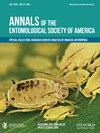Parthenogenesis and Sex-Ratio Distorting Bacteria in Empoasca (Hemiptera: Cicadellidae) Leafhoppers
IF 1.8
3区 农林科学
Q1 ENTOMOLOGY
引用次数: 3
Abstract
Abstract Endosymbiotic bacteria can induce parthenogenesis in many haplo-diploid species, but little is known about their role in asexual reproduction in diplodiploids. Bacteria are essential for reproduction in the asexual lineages of springtails and booklice, and possibly some weevils, but whether they are the causative agent of parthenogenesis remains to be proven. This would require comparing unisexual forms and their closely related bisexual species, but such model species are very rare. Empoasca leafhoppers from the Madeira Archipelago provide an excellent case to test whether bacterial infections can cause parthenogenesis. Here we examined the diversity of the sex-distorting bacteria, Wolbachia, Cardinium, Rickettsia, and Arsenophonus, in three apomictic morphotypes (A, B, C) and three bisexual relatives of Empoasca. Wolbachia of group B was present in all unisexual and bisexual species. Rickettsia were the only bacteria restricted to the three unisexual forms, suggesting an association between infection and asexual reproduction. In addition, we found Asaia for the third time in the Cicadellidae, although this may have little to do with the reproductive mode of its host. Adult females of morphotype C reared on plants watered with tetracycline solution did not result in the production of male offspring. To our knowledge, this is the first study to suggest a possible association between bacterial infection and parthenogenesis in apomictic XO/XX diplodiploid bisexual species based on a range of sex ratio-distorting bacteria.Empoasca(半翅目:蝉科)叶蝉的孤雌生殖和性比畸变细菌
摘要内共生细菌可以诱导许多单倍二倍体物种的单性生殖,但对其在二倍体无性繁殖中的作用知之甚少。细菌对弹尾虫和书虱的无性系繁殖至关重要,可能还有一些象鼻虫,但它们是否是孤雌生殖的病原体还有待证明。这需要比较单性形态及其亲缘关系密切的两性物种,但这种模式物种非常罕见。马德拉群岛的Empoasca叶蝉提供了一个极好的案例来测试细菌感染是否会导致孤雌生殖。在这里,我们检测了三种无融合体形态类型(A、B、C)和Empoasca的三个两性亲缘关系中的性别扭曲细菌Wolbachia、Cardinium、立克次体和Arsenophonus的多样性。B组的沃尔巴克氏体存在于所有单性和两性物种中。立克次体是唯一局限于三种单性形式的细菌,这表明感染和无性繁殖之间存在联系。此外,我们在蝉科中第三次发现了Asaia,尽管这可能与宿主的繁殖模式无关。在用四环素溶液浇灌的植物上饲养的C型成年雌性不会产生雄性后代。据我们所知,这是第一项基于一系列性别比扭曲细菌的研究,表明细菌感染与无融合生殖XO/XX双二倍体两性物种的孤雌生殖之间可能存在关联。
本文章由计算机程序翻译,如有差异,请以英文原文为准。
求助全文
约1分钟内获得全文
求助全文
来源期刊
CiteScore
4.90
自引率
0.00%
发文量
25
审稿时长
6-12 weeks
期刊介绍:
The Annals of the Entomological Society of America exists to stimulate interdisciplinary dialogue across the entomological disciplines and to advance cooperative interaction among diverse groups of entomologists. It seeks to attract and publish cutting-edge research, reviews, collections of articles on a common topic of broad interest, and discussion of topics with national or international importance. We especially welcome articles covering developing areas of research, controversial issues or debate, and topics of importance to society. Manuscripts that are primarily reports of new species, methodology, pest management, or the biology of single species generally will be referred to other journals of the ESA. The most important criteria for acceptance are quality of work and breadth of interest to the readership.

 求助内容:
求助内容: 应助结果提醒方式:
应助结果提醒方式:


